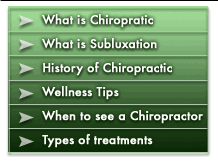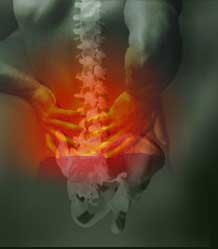|
|
Wellness Tips
The motions of daily life, if done incorrectly,
can result in injury to the spine. The following tips can
help you steer clear and prevent of that kind of pain and inconvenience and
keep you feeling your best.
Sitting
- Choose a chair that is firm enough to support
you comfortably, and don't slouch!
- Sit with your feet flat on the floor or on
a low footstool so that your knees are slightly higher than your
hips. Sit firmly against the back of the chair.
- La-z-boy chairs don't bend where you do;
choose a rocker instead.
- Avoid crossing your legs at the knees, which
can aggravate existing back conditions and interfere with circulation
to your lower limbs.
Standing
- Stand with your head level. When you
have to stand in one place for long periods of time, put one
foot on a 4-6-inch stool to help keep pressure off your spine.
- Avoid wearing high heels if you are going
to be on your feet for long periods of time.
Working at a Desk
- Take frequent stretch breaks if you have
to sit for a long time.
- Sit with your knees at a 90-120-degree angle. An
angled footrest may help you feel more comfortable.
- Make sure your chair fits correctly. Allow
for two inches between the front edge of the seat and the back
of your knees.
- Choose a chair that tilts back so you can
rest while you're reading what is on your computer screen.
- Elevate materials or your computer screen
to avoid neck fatigue.
Lifting
- Avoid twisting and turning motions when you
lift. If you have to turn to place the object, step in
the direction of the turn, don't just twist at the waist.
- Always bend at your knees, not your waist,
when lifting anything heavier than 10 percent of your body weight
(e.g., a child or heavy box).
- When lifting an object, plant your feet about
12-18 inches apart, kneel or squat in front of the object, and
lift as you straighten up. Be sure to lift with the big
muscles of your thighs, arms, and shoulders, not with your back.
- In some situations, it is difficult to lift
correctly. Getting grocery bags out of the car is one such
situation. The car bumper doesn't allow you to bend
your knees. Bring the bag to you first and then lift carefully.
- When engaging in repetitive lifting, use
good lifting form, take frequent breaks, and use equipment to
help whenever possible.
- To avoid tripping, be sure your path is clear
before you lift the item.
Physical Activity/ Household Chores
- Warm up and cool down before and after physical
activity like playing sports, raking, gardening, and shoveling
snow.
- When working with hand-held yard equipment,
make sure that the machine you are using has a strap. Place
the strap over your head and shoulder on the opposite side of
your body from the machine and switch the machine from one side
of your body to the other as often as possible. Use electric
rather than gas-powered machines whenever possible; they are
much lighter.
- When washing dishes, open the cabinet beneath
the sink, bend one knee, and put your foot on the shelf under
the sink. Lean against the counter for support.
- When ironing, place one foot on a small stool
or a book.
- When vacuuming, put all your weight on one
foot, then step forward and back with the other foot as you push
the vacuum. Use your back foot as a pivot when you turn.
Using the Telephone
- When using the telephone, avoid cradling
the receiver between your neck and shoulder. Hold the phone
in your hand or use speakerphone instead.
- If you use the phone a lot, use a lightweight headset.
- Switch hands frequently when on the phone.
Resting/Sleeping
- Don't use a sofa arm as a pillow or
watch TV in bed with your head supported only by pillows; this
strains your neck.
- Avoid sleeping on a soft mattress or sofa.
- Lie down in bed when it is time to sleep. Don't
sleep in a chair or in cramped quarters.
- Sleep on your side with your knees bent or
on your back with a pillow under your knees. Avoid sleeping
on your stomach.
- Use a pillow that supports your head so that
your neck and vertebrae are level with the rest of your spine
as you sleep. Avoid sleeping on two pillows.
- Be sure to get plenty of sleep every day
to allow your body to rest and recuperate.
|
|





